NURS1008 Assignment 3: Deconstruction Essay on Aboriginal Health
VerifiedAdded on 2022/12/19
|8
|2366
|1
Essay
AI Summary
This deconstruction essay examines the question of why Aboriginal people are prone to alcohol and substance abuse. It begins by defining key terminologies like "Aboriginal," "alcohol," and "substance abuse." The essay then delves into the assumptions and concepts underlying the question, highlighting historical factors such as colonization, racism, and marginalization, as well as socioeconomic issues like lack of healthcare, education, and employment. Stereotypes related to the situation are discussed, linking them to professional nursing practices and the need for culturally sensitive healthcare interventions. The essay explores the hidden messages within the question, questioning whether alcohol and substance abuse are the sole determinants of Aboriginal health issues. The analysis emphasizes the impact of social, economic, and educational disparities, as well as the gap between Aboriginal and non-Aboriginal Australians. It concludes by advocating for improved awareness, education, and culturally appropriate healthcare to address the complex health challenges faced by Aboriginal communities.
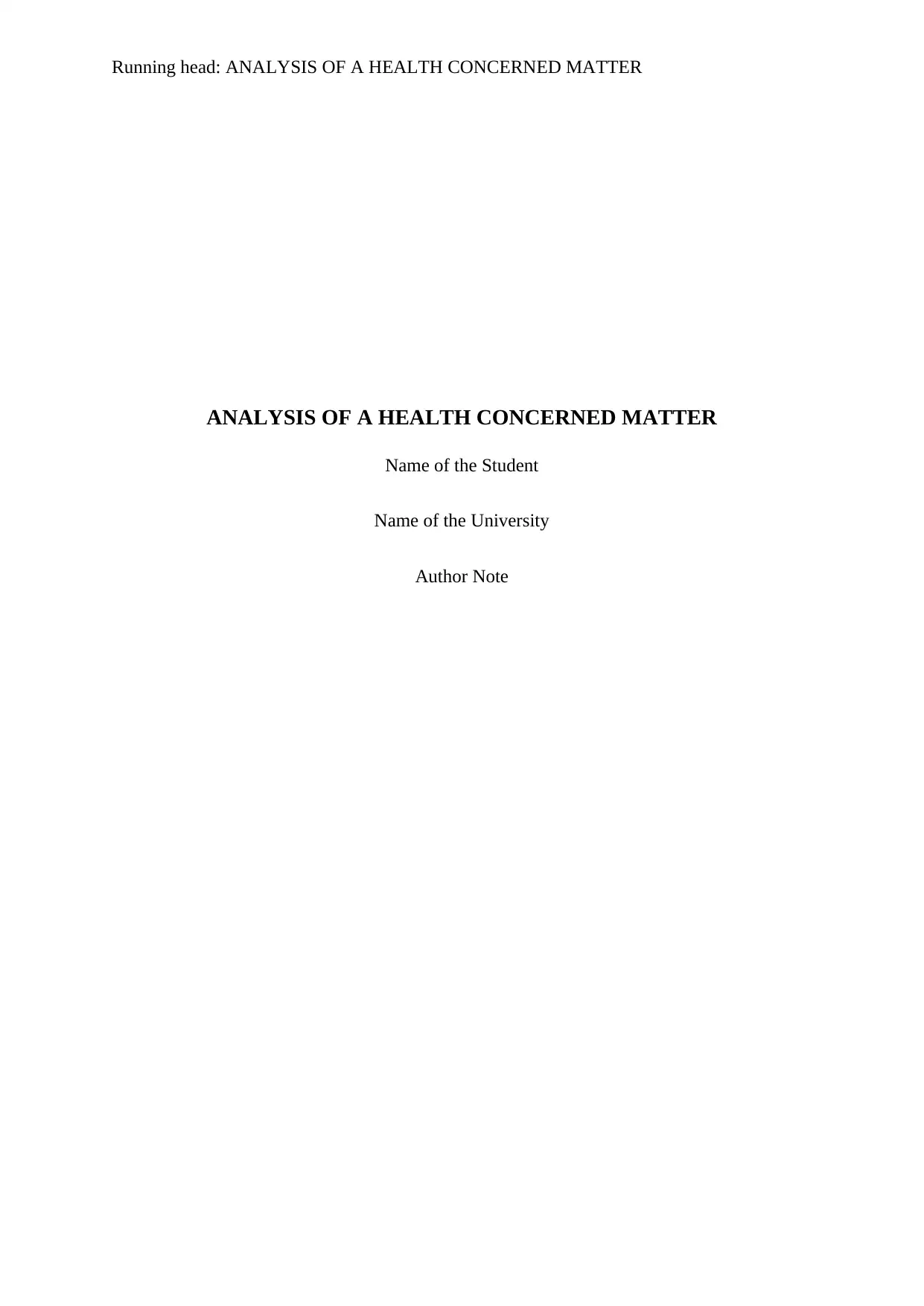
Running head: ANALYSIS OF A HEALTH CONCERNED MATTER
ANALYSIS OF A HEALTH CONCERNED MATTER
Name of the Student
Name of the University
Author Note
ANALYSIS OF A HEALTH CONCERNED MATTER
Name of the Student
Name of the University
Author Note
Paraphrase This Document
Need a fresh take? Get an instant paraphrase of this document with our AI Paraphraser
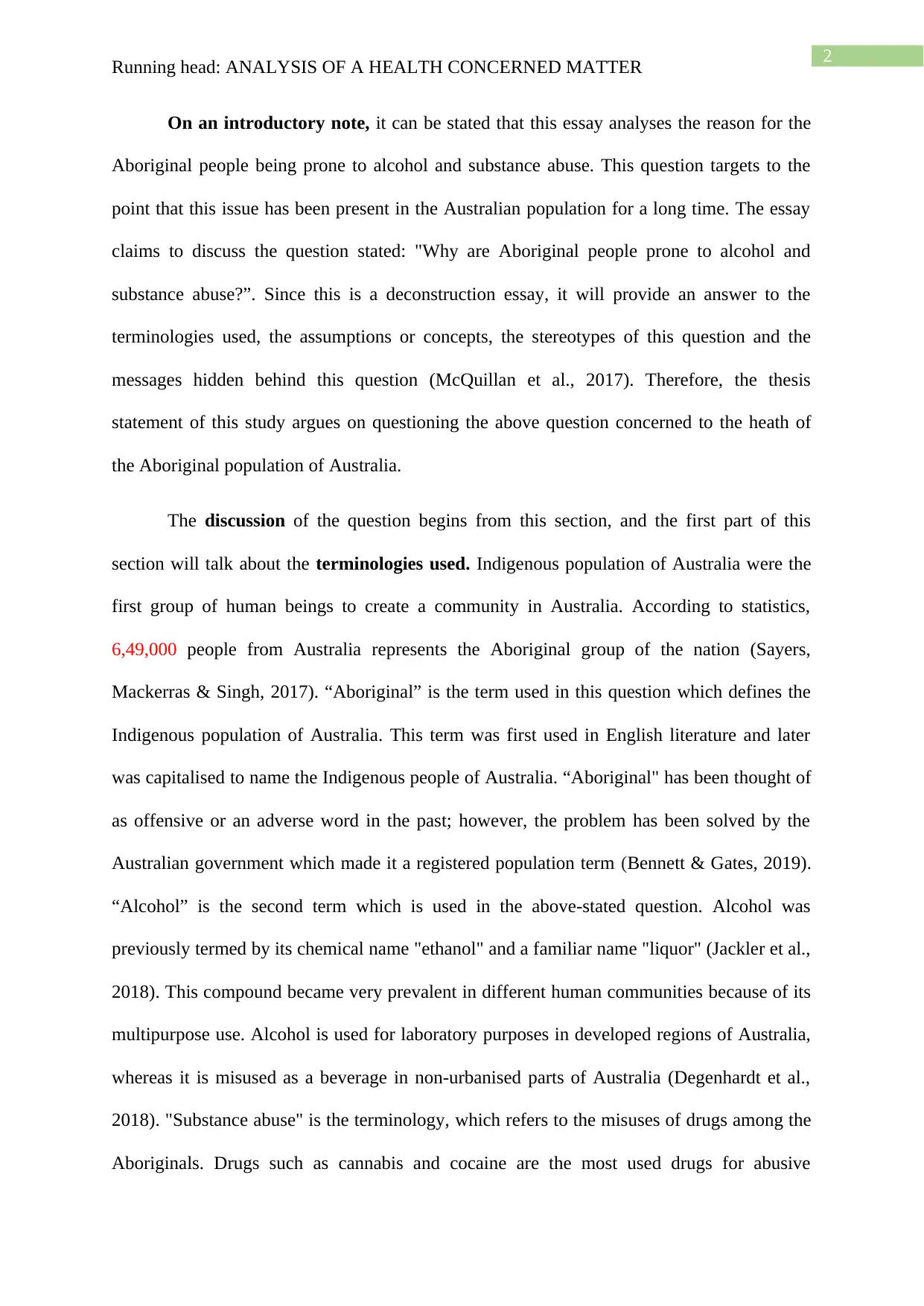
2
Running head: ANALYSIS OF A HEALTH CONCERNED MATTER
On an introductory note, it can be stated that this essay analyses the reason for the
Aboriginal people being prone to alcohol and substance abuse. This question targets to the
point that this issue has been present in the Australian population for a long time. The essay
claims to discuss the question stated: "Why are Aboriginal people prone to alcohol and
substance abuse?”. Since this is a deconstruction essay, it will provide an answer to the
terminologies used, the assumptions or concepts, the stereotypes of this question and the
messages hidden behind this question (McQuillan et al., 2017). Therefore, the thesis
statement of this study argues on questioning the above question concerned to the heath of
the Aboriginal population of Australia.
The discussion of the question begins from this section, and the first part of this
section will talk about the terminologies used. Indigenous population of Australia were the
first group of human beings to create a community in Australia. According to statistics,
6,49,000 people from Australia represents the Aboriginal group of the nation (Sayers,
Mackerras & Singh, 2017). “Aboriginal” is the term used in this question which defines the
Indigenous population of Australia. This term was first used in English literature and later
was capitalised to name the Indigenous people of Australia. “Aboriginal" has been thought of
as offensive or an adverse word in the past; however, the problem has been solved by the
Australian government which made it a registered population term (Bennett & Gates, 2019).
“Alcohol” is the second term which is used in the above-stated question. Alcohol was
previously termed by its chemical name "ethanol" and a familiar name "liquor" (Jackler et al.,
2018). This compound became very prevalent in different human communities because of its
multipurpose use. Alcohol is used for laboratory purposes in developed regions of Australia,
whereas it is misused as a beverage in non-urbanised parts of Australia (Degenhardt et al.,
2018). "Substance abuse" is the terminology, which refers to the misuses of drugs among the
Aboriginals. Drugs such as cannabis and cocaine are the most used drugs for abusive
Running head: ANALYSIS OF A HEALTH CONCERNED MATTER
On an introductory note, it can be stated that this essay analyses the reason for the
Aboriginal people being prone to alcohol and substance abuse. This question targets to the
point that this issue has been present in the Australian population for a long time. The essay
claims to discuss the question stated: "Why are Aboriginal people prone to alcohol and
substance abuse?”. Since this is a deconstruction essay, it will provide an answer to the
terminologies used, the assumptions or concepts, the stereotypes of this question and the
messages hidden behind this question (McQuillan et al., 2017). Therefore, the thesis
statement of this study argues on questioning the above question concerned to the heath of
the Aboriginal population of Australia.
The discussion of the question begins from this section, and the first part of this
section will talk about the terminologies used. Indigenous population of Australia were the
first group of human beings to create a community in Australia. According to statistics,
6,49,000 people from Australia represents the Aboriginal group of the nation (Sayers,
Mackerras & Singh, 2017). “Aboriginal” is the term used in this question which defines the
Indigenous population of Australia. This term was first used in English literature and later
was capitalised to name the Indigenous people of Australia. “Aboriginal" has been thought of
as offensive or an adverse word in the past; however, the problem has been solved by the
Australian government which made it a registered population term (Bennett & Gates, 2019).
“Alcohol” is the second term which is used in the above-stated question. Alcohol was
previously termed by its chemical name "ethanol" and a familiar name "liquor" (Jackler et al.,
2018). This compound became very prevalent in different human communities because of its
multipurpose use. Alcohol is used for laboratory purposes in developed regions of Australia,
whereas it is misused as a beverage in non-urbanised parts of Australia (Degenhardt et al.,
2018). "Substance abuse" is the terminology, which refers to the misuses of drugs among the
Aboriginals. Drugs such as cannabis and cocaine are the most used drugs for abusive
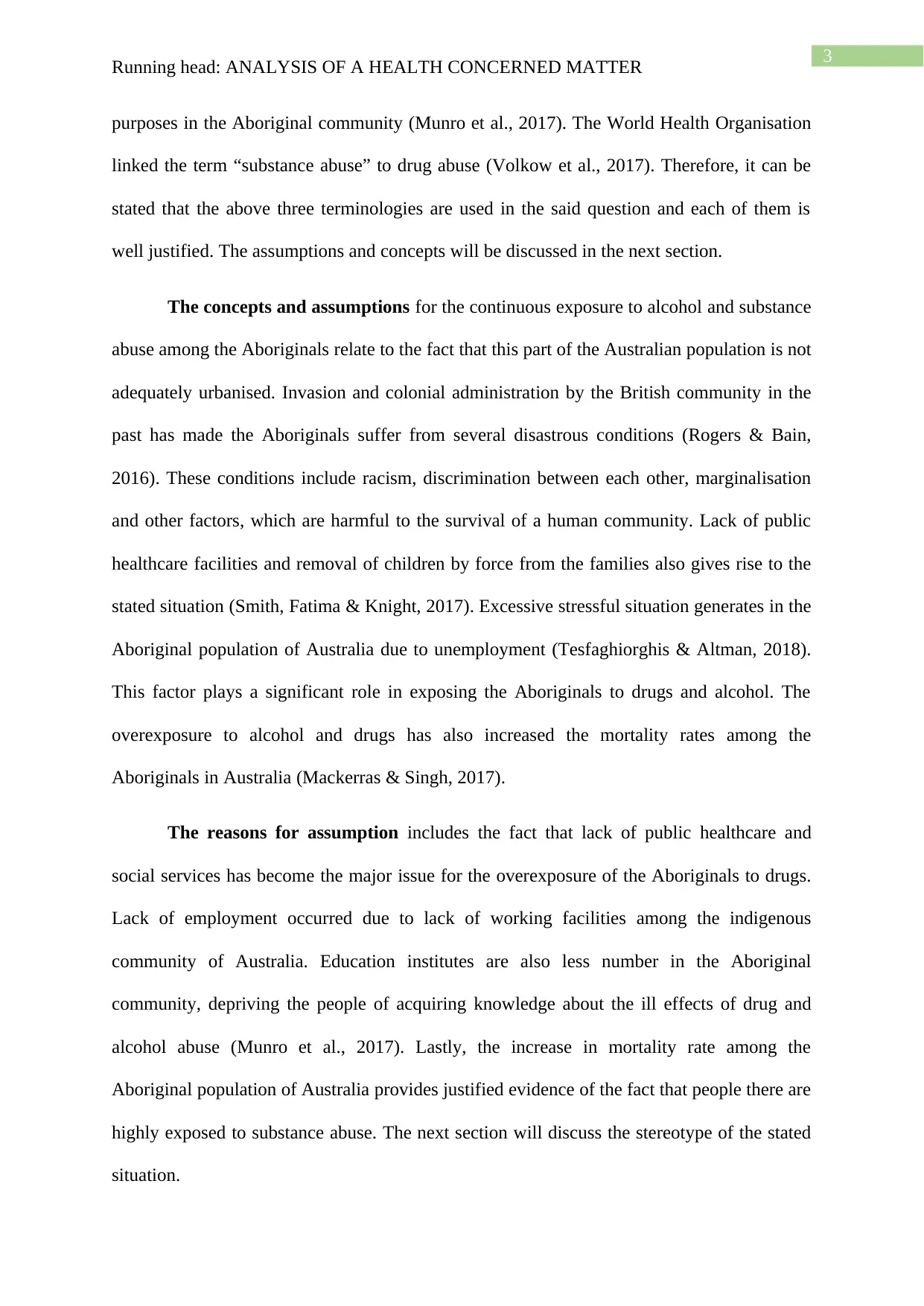
3
Running head: ANALYSIS OF A HEALTH CONCERNED MATTER
purposes in the Aboriginal community (Munro et al., 2017). The World Health Organisation
linked the term “substance abuse” to drug abuse (Volkow et al., 2017). Therefore, it can be
stated that the above three terminologies are used in the said question and each of them is
well justified. The assumptions and concepts will be discussed in the next section.
The concepts and assumptions for the continuous exposure to alcohol and substance
abuse among the Aboriginals relate to the fact that this part of the Australian population is not
adequately urbanised. Invasion and colonial administration by the British community in the
past has made the Aboriginals suffer from several disastrous conditions (Rogers & Bain,
2016). These conditions include racism, discrimination between each other, marginalisation
and other factors, which are harmful to the survival of a human community. Lack of public
healthcare facilities and removal of children by force from the families also gives rise to the
stated situation (Smith, Fatima & Knight, 2017). Excessive stressful situation generates in the
Aboriginal population of Australia due to unemployment (Tesfaghiorghis & Altman, 2018).
This factor plays a significant role in exposing the Aboriginals to drugs and alcohol. The
overexposure to alcohol and drugs has also increased the mortality rates among the
Aboriginals in Australia (Mackerras & Singh, 2017).
The reasons for assumption includes the fact that lack of public healthcare and
social services has become the major issue for the overexposure of the Aboriginals to drugs.
Lack of employment occurred due to lack of working facilities among the indigenous
community of Australia. Education institutes are also less number in the Aboriginal
community, depriving the people of acquiring knowledge about the ill effects of drug and
alcohol abuse (Munro et al., 2017). Lastly, the increase in mortality rate among the
Aboriginal population of Australia provides justified evidence of the fact that people there are
highly exposed to substance abuse. The next section will discuss the stereotype of the stated
situation.
Running head: ANALYSIS OF A HEALTH CONCERNED MATTER
purposes in the Aboriginal community (Munro et al., 2017). The World Health Organisation
linked the term “substance abuse” to drug abuse (Volkow et al., 2017). Therefore, it can be
stated that the above three terminologies are used in the said question and each of them is
well justified. The assumptions and concepts will be discussed in the next section.
The concepts and assumptions for the continuous exposure to alcohol and substance
abuse among the Aboriginals relate to the fact that this part of the Australian population is not
adequately urbanised. Invasion and colonial administration by the British community in the
past has made the Aboriginals suffer from several disastrous conditions (Rogers & Bain,
2016). These conditions include racism, discrimination between each other, marginalisation
and other factors, which are harmful to the survival of a human community. Lack of public
healthcare facilities and removal of children by force from the families also gives rise to the
stated situation (Smith, Fatima & Knight, 2017). Excessive stressful situation generates in the
Aboriginal population of Australia due to unemployment (Tesfaghiorghis & Altman, 2018).
This factor plays a significant role in exposing the Aboriginals to drugs and alcohol. The
overexposure to alcohol and drugs has also increased the mortality rates among the
Aboriginals in Australia (Mackerras & Singh, 2017).
The reasons for assumption includes the fact that lack of public healthcare and
social services has become the major issue for the overexposure of the Aboriginals to drugs.
Lack of employment occurred due to lack of working facilities among the indigenous
community of Australia. Education institutes are also less number in the Aboriginal
community, depriving the people of acquiring knowledge about the ill effects of drug and
alcohol abuse (Munro et al., 2017). Lastly, the increase in mortality rate among the
Aboriginal population of Australia provides justified evidence of the fact that people there are
highly exposed to substance abuse. The next section will discuss the stereotype of the stated
situation.
⊘ This is a preview!⊘
Do you want full access?
Subscribe today to unlock all pages.

Trusted by 1+ million students worldwide
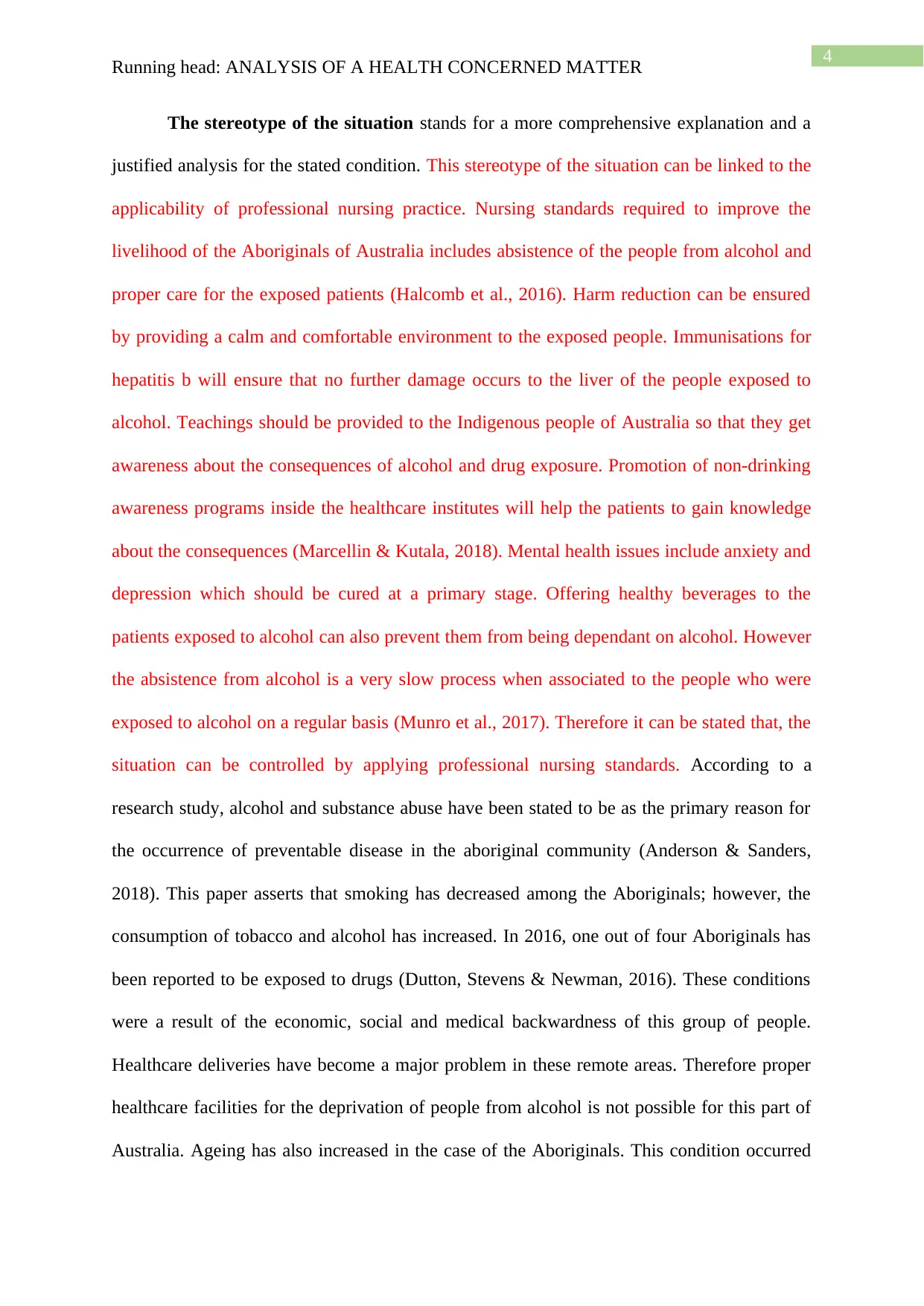
4
Running head: ANALYSIS OF A HEALTH CONCERNED MATTER
The stereotype of the situation stands for a more comprehensive explanation and a
justified analysis for the stated condition. This stereotype of the situation can be linked to the
applicability of professional nursing practice. Nursing standards required to improve the
livelihood of the Aboriginals of Australia includes absistence of the people from alcohol and
proper care for the exposed patients (Halcomb et al., 2016). Harm reduction can be ensured
by providing a calm and comfortable environment to the exposed people. Immunisations for
hepatitis b will ensure that no further damage occurs to the liver of the people exposed to
alcohol. Teachings should be provided to the Indigenous people of Australia so that they get
awareness about the consequences of alcohol and drug exposure. Promotion of non-drinking
awareness programs inside the healthcare institutes will help the patients to gain knowledge
about the consequences (Marcellin & Kutala, 2018). Mental health issues include anxiety and
depression which should be cured at a primary stage. Offering healthy beverages to the
patients exposed to alcohol can also prevent them from being dependant on alcohol. However
the absistence from alcohol is a very slow process when associated to the people who were
exposed to alcohol on a regular basis (Munro et al., 2017). Therefore it can be stated that, the
situation can be controlled by applying professional nursing standards. According to a
research study, alcohol and substance abuse have been stated to be as the primary reason for
the occurrence of preventable disease in the aboriginal community (Anderson & Sanders,
2018). This paper asserts that smoking has decreased among the Aboriginals; however, the
consumption of tobacco and alcohol has increased. In 2016, one out of four Aboriginals has
been reported to be exposed to drugs (Dutton, Stevens & Newman, 2016). These conditions
were a result of the economic, social and medical backwardness of this group of people.
Healthcare deliveries have become a major problem in these remote areas. Therefore proper
healthcare facilities for the deprivation of people from alcohol is not possible for this part of
Australia. Ageing has also increased in the case of the Aboriginals. This condition occurred
Running head: ANALYSIS OF A HEALTH CONCERNED MATTER
The stereotype of the situation stands for a more comprehensive explanation and a
justified analysis for the stated condition. This stereotype of the situation can be linked to the
applicability of professional nursing practice. Nursing standards required to improve the
livelihood of the Aboriginals of Australia includes absistence of the people from alcohol and
proper care for the exposed patients (Halcomb et al., 2016). Harm reduction can be ensured
by providing a calm and comfortable environment to the exposed people. Immunisations for
hepatitis b will ensure that no further damage occurs to the liver of the people exposed to
alcohol. Teachings should be provided to the Indigenous people of Australia so that they get
awareness about the consequences of alcohol and drug exposure. Promotion of non-drinking
awareness programs inside the healthcare institutes will help the patients to gain knowledge
about the consequences (Marcellin & Kutala, 2018). Mental health issues include anxiety and
depression which should be cured at a primary stage. Offering healthy beverages to the
patients exposed to alcohol can also prevent them from being dependant on alcohol. However
the absistence from alcohol is a very slow process when associated to the people who were
exposed to alcohol on a regular basis (Munro et al., 2017). Therefore it can be stated that, the
situation can be controlled by applying professional nursing standards. According to a
research study, alcohol and substance abuse have been stated to be as the primary reason for
the occurrence of preventable disease in the aboriginal community (Anderson & Sanders,
2018). This paper asserts that smoking has decreased among the Aboriginals; however, the
consumption of tobacco and alcohol has increased. In 2016, one out of four Aboriginals has
been reported to be exposed to drugs (Dutton, Stevens & Newman, 2016). These conditions
were a result of the economic, social and medical backwardness of this group of people.
Healthcare deliveries have become a major problem in these remote areas. Therefore proper
healthcare facilities for the deprivation of people from alcohol is not possible for this part of
Australia. Ageing has also increased in the case of the Aboriginals. This condition occurred
Paraphrase This Document
Need a fresh take? Get an instant paraphrase of this document with our AI Paraphraser
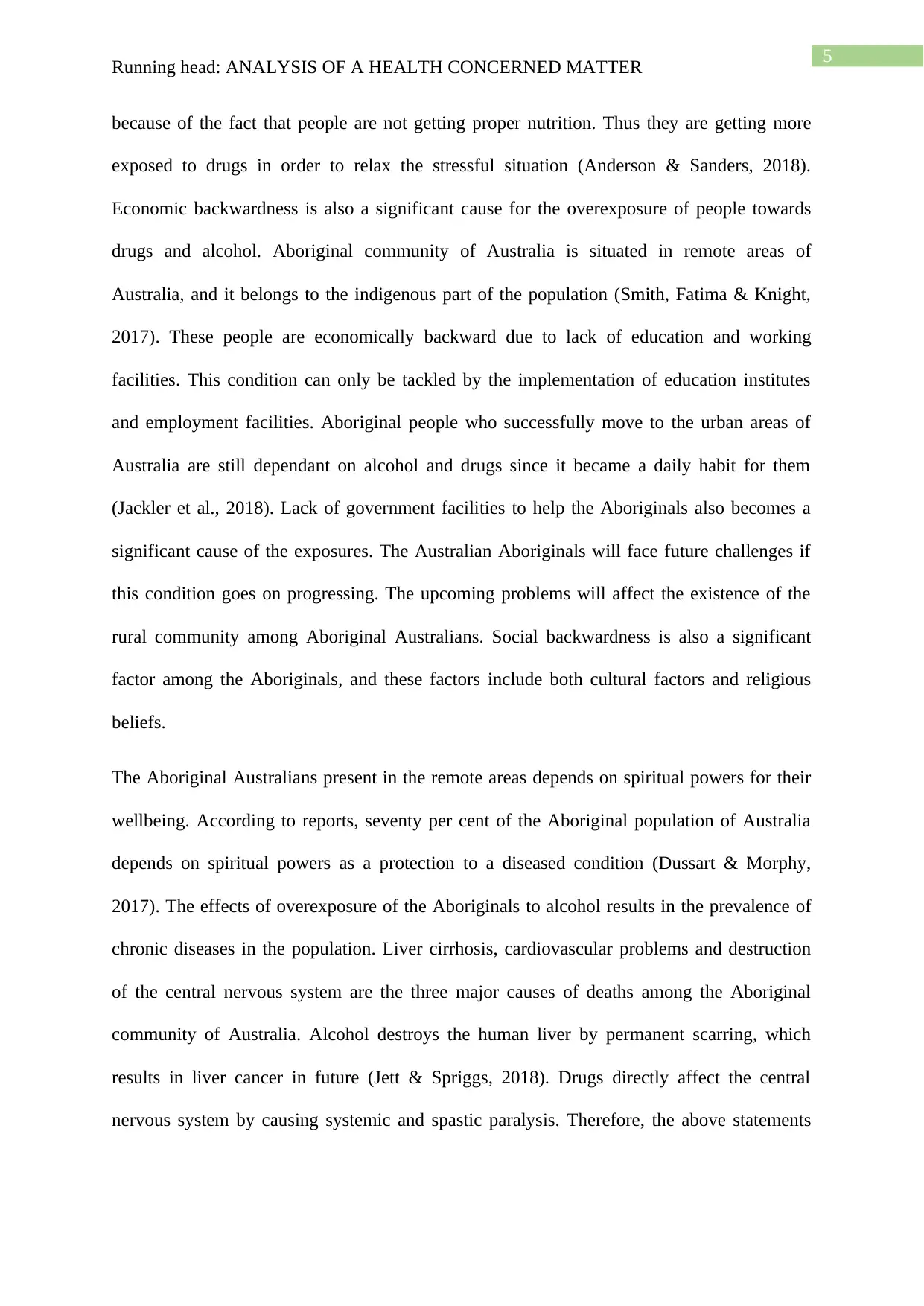
5
Running head: ANALYSIS OF A HEALTH CONCERNED MATTER
because of the fact that people are not getting proper nutrition. Thus they are getting more
exposed to drugs in order to relax the stressful situation (Anderson & Sanders, 2018).
Economic backwardness is also a significant cause for the overexposure of people towards
drugs and alcohol. Aboriginal community of Australia is situated in remote areas of
Australia, and it belongs to the indigenous part of the population (Smith, Fatima & Knight,
2017). These people are economically backward due to lack of education and working
facilities. This condition can only be tackled by the implementation of education institutes
and employment facilities. Aboriginal people who successfully move to the urban areas of
Australia are still dependant on alcohol and drugs since it became a daily habit for them
(Jackler et al., 2018). Lack of government facilities to help the Aboriginals also becomes a
significant cause of the exposures. The Australian Aboriginals will face future challenges if
this condition goes on progressing. The upcoming problems will affect the existence of the
rural community among Aboriginal Australians. Social backwardness is also a significant
factor among the Aboriginals, and these factors include both cultural factors and religious
beliefs.
The Aboriginal Australians present in the remote areas depends on spiritual powers for their
wellbeing. According to reports, seventy per cent of the Aboriginal population of Australia
depends on spiritual powers as a protection to a diseased condition (Dussart & Morphy,
2017). The effects of overexposure of the Aboriginals to alcohol results in the prevalence of
chronic diseases in the population. Liver cirrhosis, cardiovascular problems and destruction
of the central nervous system are the three major causes of deaths among the Aboriginal
community of Australia. Alcohol destroys the human liver by permanent scarring, which
results in liver cancer in future (Jett & Spriggs, 2018). Drugs directly affect the central
nervous system by causing systemic and spastic paralysis. Therefore, the above statements
Running head: ANALYSIS OF A HEALTH CONCERNED MATTER
because of the fact that people are not getting proper nutrition. Thus they are getting more
exposed to drugs in order to relax the stressful situation (Anderson & Sanders, 2018).
Economic backwardness is also a significant cause for the overexposure of people towards
drugs and alcohol. Aboriginal community of Australia is situated in remote areas of
Australia, and it belongs to the indigenous part of the population (Smith, Fatima & Knight,
2017). These people are economically backward due to lack of education and working
facilities. This condition can only be tackled by the implementation of education institutes
and employment facilities. Aboriginal people who successfully move to the urban areas of
Australia are still dependant on alcohol and drugs since it became a daily habit for them
(Jackler et al., 2018). Lack of government facilities to help the Aboriginals also becomes a
significant cause of the exposures. The Australian Aboriginals will face future challenges if
this condition goes on progressing. The upcoming problems will affect the existence of the
rural community among Aboriginal Australians. Social backwardness is also a significant
factor among the Aboriginals, and these factors include both cultural factors and religious
beliefs.
The Aboriginal Australians present in the remote areas depends on spiritual powers for their
wellbeing. According to reports, seventy per cent of the Aboriginal population of Australia
depends on spiritual powers as a protection to a diseased condition (Dussart & Morphy,
2017). The effects of overexposure of the Aboriginals to alcohol results in the prevalence of
chronic diseases in the population. Liver cirrhosis, cardiovascular problems and destruction
of the central nervous system are the three major causes of deaths among the Aboriginal
community of Australia. Alcohol destroys the human liver by permanent scarring, which
results in liver cancer in future (Jett & Spriggs, 2018). Drugs directly affect the central
nervous system by causing systemic and spastic paralysis. Therefore, the above statements
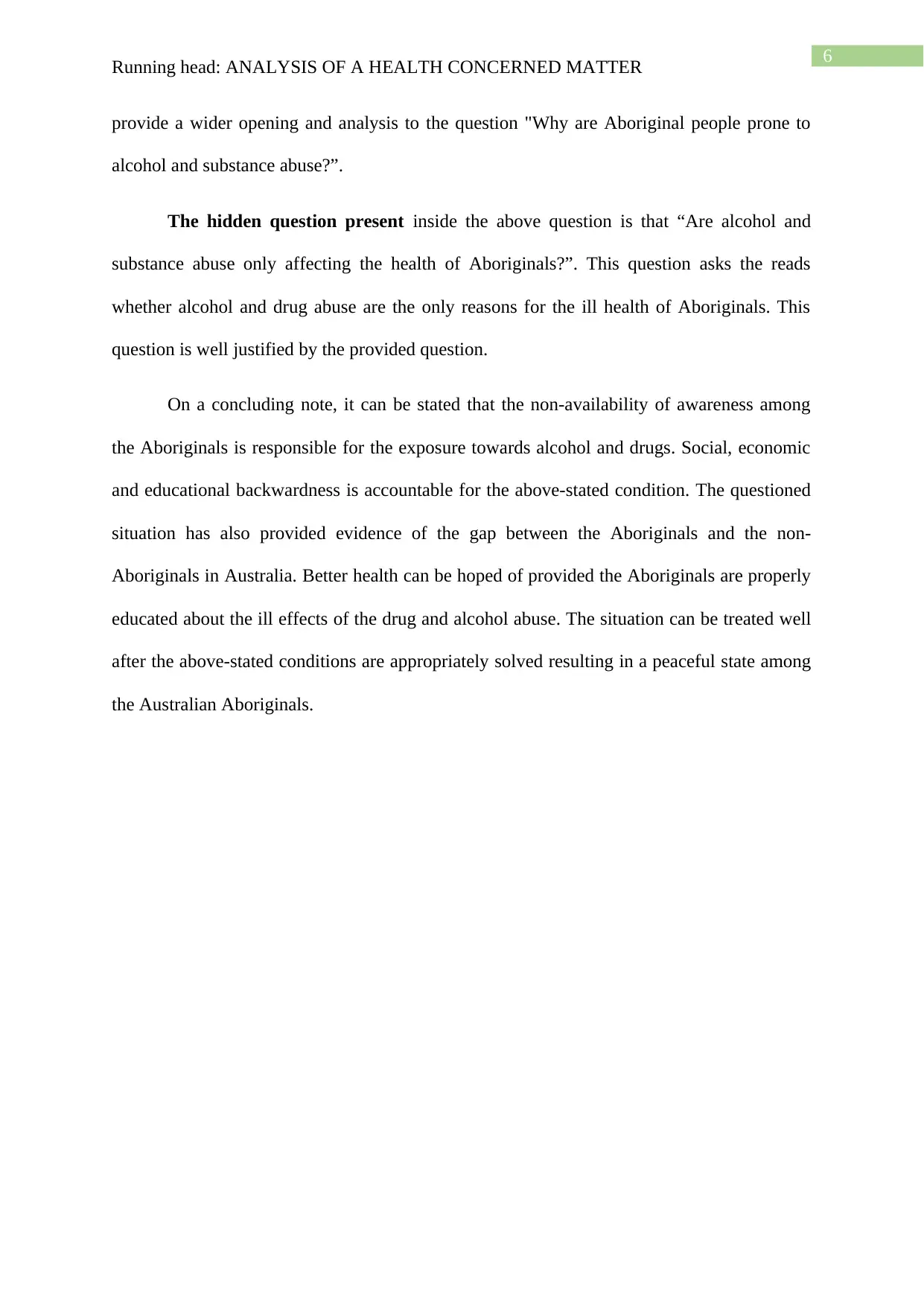
6
Running head: ANALYSIS OF A HEALTH CONCERNED MATTER
provide a wider opening and analysis to the question "Why are Aboriginal people prone to
alcohol and substance abuse?”.
The hidden question present inside the above question is that “Are alcohol and
substance abuse only affecting the health of Aboriginals?”. This question asks the reads
whether alcohol and drug abuse are the only reasons for the ill health of Aboriginals. This
question is well justified by the provided question.
On a concluding note, it can be stated that the non-availability of awareness among
the Aboriginals is responsible for the exposure towards alcohol and drugs. Social, economic
and educational backwardness is accountable for the above-stated condition. The questioned
situation has also provided evidence of the gap between the Aboriginals and the non-
Aboriginals in Australia. Better health can be hoped of provided the Aboriginals are properly
educated about the ill effects of the drug and alcohol abuse. The situation can be treated well
after the above-stated conditions are appropriately solved resulting in a peaceful state among
the Australian Aboriginals.
Running head: ANALYSIS OF A HEALTH CONCERNED MATTER
provide a wider opening and analysis to the question "Why are Aboriginal people prone to
alcohol and substance abuse?”.
The hidden question present inside the above question is that “Are alcohol and
substance abuse only affecting the health of Aboriginals?”. This question asks the reads
whether alcohol and drug abuse are the only reasons for the ill health of Aboriginals. This
question is well justified by the provided question.
On a concluding note, it can be stated that the non-availability of awareness among
the Aboriginals is responsible for the exposure towards alcohol and drugs. Social, economic
and educational backwardness is accountable for the above-stated condition. The questioned
situation has also provided evidence of the gap between the Aboriginals and the non-
Aboriginals in Australia. Better health can be hoped of provided the Aboriginals are properly
educated about the ill effects of the drug and alcohol abuse. The situation can be treated well
after the above-stated conditions are appropriately solved resulting in a peaceful state among
the Australian Aboriginals.
⊘ This is a preview!⊘
Do you want full access?
Subscribe today to unlock all pages.

Trusted by 1+ million students worldwide
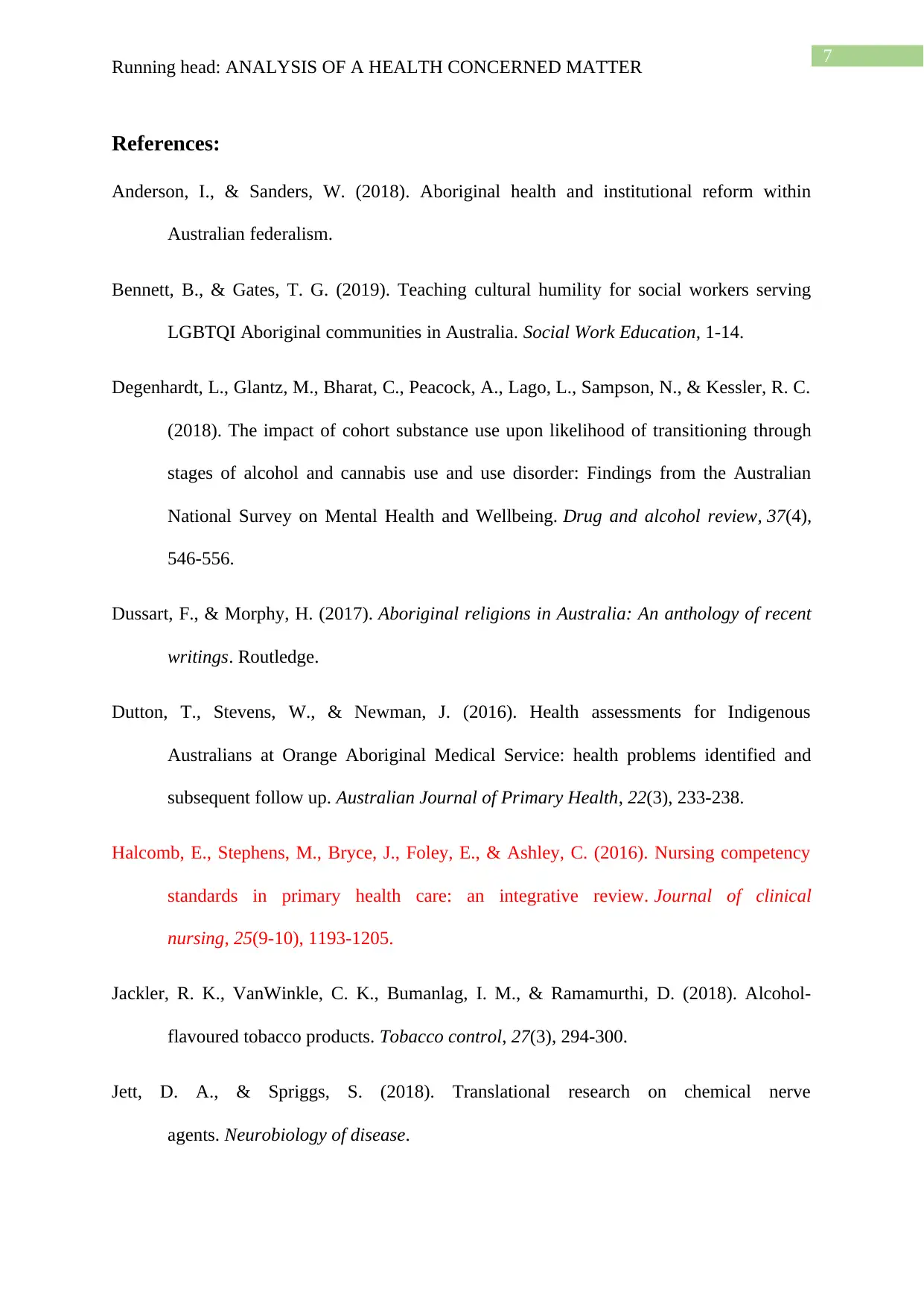
7
Running head: ANALYSIS OF A HEALTH CONCERNED MATTER
References:
Anderson, I., & Sanders, W. (2018). Aboriginal health and institutional reform within
Australian federalism.
Bennett, B., & Gates, T. G. (2019). Teaching cultural humility for social workers serving
LGBTQI Aboriginal communities in Australia. Social Work Education, 1-14.
Degenhardt, L., Glantz, M., Bharat, C., Peacock, A., Lago, L., Sampson, N., & Kessler, R. C.
(2018). The impact of cohort substance use upon likelihood of transitioning through
stages of alcohol and cannabis use and use disorder: Findings from the Australian
National Survey on Mental Health and Wellbeing. Drug and alcohol review, 37(4),
546-556.
Dussart, F., & Morphy, H. (2017). Aboriginal religions in Australia: An anthology of recent
writings. Routledge.
Dutton, T., Stevens, W., & Newman, J. (2016). Health assessments for Indigenous
Australians at Orange Aboriginal Medical Service: health problems identified and
subsequent follow up. Australian Journal of Primary Health, 22(3), 233-238.
Halcomb, E., Stephens, M., Bryce, J., Foley, E., & Ashley, C. (2016). Nursing competency
standards in primary health care: an integrative review. Journal of clinical
nursing, 25(9-10), 1193-1205.
Jackler, R. K., VanWinkle, C. K., Bumanlag, I. M., & Ramamurthi, D. (2018). Alcohol-
flavoured tobacco products. Tobacco control, 27(3), 294-300.
Jett, D. A., & Spriggs, S. (2018). Translational research on chemical nerve
agents. Neurobiology of disease.
Running head: ANALYSIS OF A HEALTH CONCERNED MATTER
References:
Anderson, I., & Sanders, W. (2018). Aboriginal health and institutional reform within
Australian federalism.
Bennett, B., & Gates, T. G. (2019). Teaching cultural humility for social workers serving
LGBTQI Aboriginal communities in Australia. Social Work Education, 1-14.
Degenhardt, L., Glantz, M., Bharat, C., Peacock, A., Lago, L., Sampson, N., & Kessler, R. C.
(2018). The impact of cohort substance use upon likelihood of transitioning through
stages of alcohol and cannabis use and use disorder: Findings from the Australian
National Survey on Mental Health and Wellbeing. Drug and alcohol review, 37(4),
546-556.
Dussart, F., & Morphy, H. (2017). Aboriginal religions in Australia: An anthology of recent
writings. Routledge.
Dutton, T., Stevens, W., & Newman, J. (2016). Health assessments for Indigenous
Australians at Orange Aboriginal Medical Service: health problems identified and
subsequent follow up. Australian Journal of Primary Health, 22(3), 233-238.
Halcomb, E., Stephens, M., Bryce, J., Foley, E., & Ashley, C. (2016). Nursing competency
standards in primary health care: an integrative review. Journal of clinical
nursing, 25(9-10), 1193-1205.
Jackler, R. K., VanWinkle, C. K., Bumanlag, I. M., & Ramamurthi, D. (2018). Alcohol-
flavoured tobacco products. Tobacco control, 27(3), 294-300.
Jett, D. A., & Spriggs, S. (2018). Translational research on chemical nerve
agents. Neurobiology of disease.
Paraphrase This Document
Need a fresh take? Get an instant paraphrase of this document with our AI Paraphraser
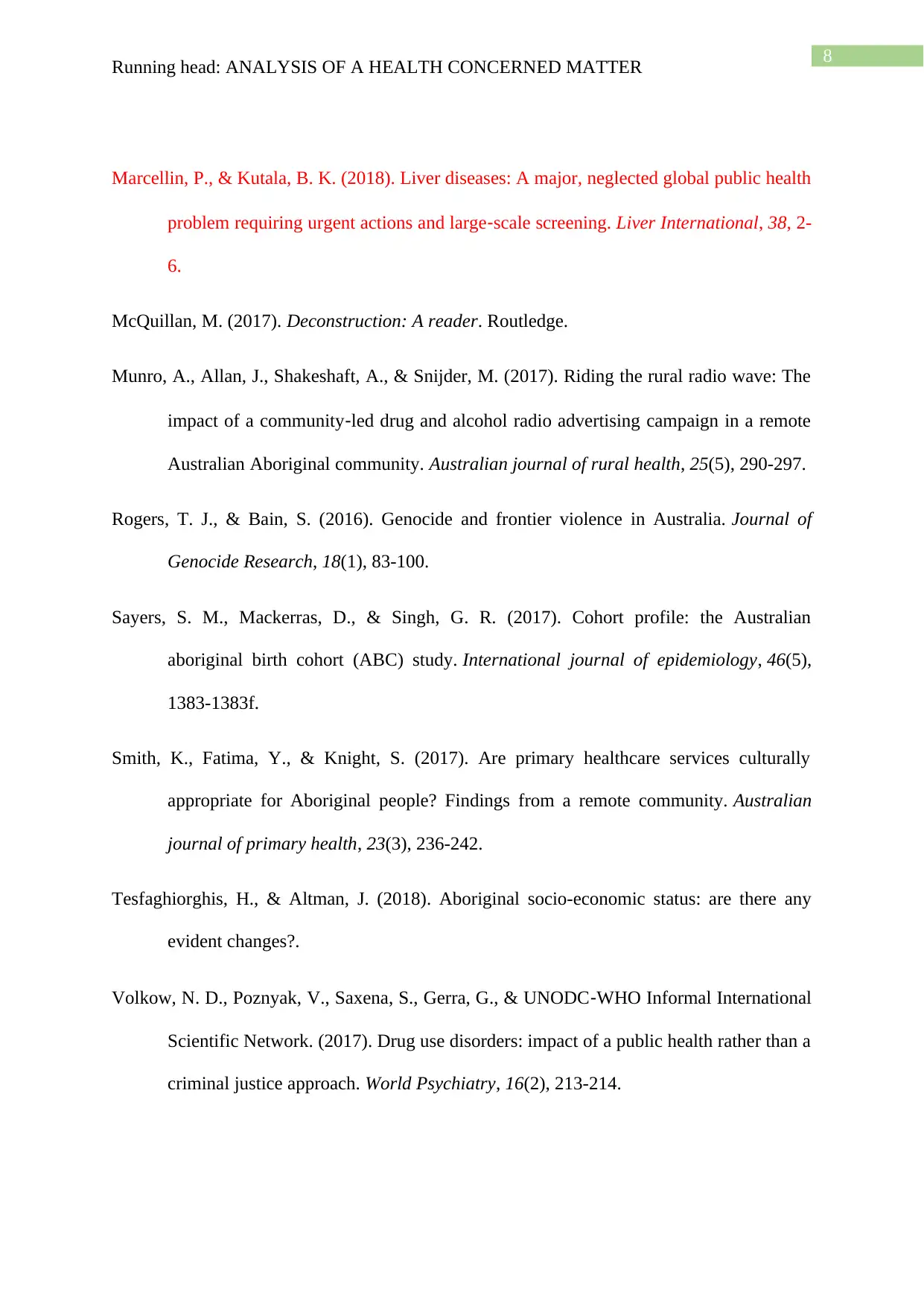
8
Running head: ANALYSIS OF A HEALTH CONCERNED MATTER
Marcellin, P., & Kutala, B. K. (2018). Liver diseases: A major, neglected global public health
problem requiring urgent actions and large‐scale screening. Liver International, 38, 2-
6.
McQuillan, M. (2017). Deconstruction: A reader. Routledge.
Munro, A., Allan, J., Shakeshaft, A., & Snijder, M. (2017). Riding the rural radio wave: The
impact of a community‐led drug and alcohol radio advertising campaign in a remote
Australian Aboriginal community. Australian journal of rural health, 25(5), 290-297.
Rogers, T. J., & Bain, S. (2016). Genocide and frontier violence in Australia. Journal of
Genocide Research, 18(1), 83-100.
Sayers, S. M., Mackerras, D., & Singh, G. R. (2017). Cohort profile: the Australian
aboriginal birth cohort (ABC) study. International journal of epidemiology, 46(5),
1383-1383f.
Smith, K., Fatima, Y., & Knight, S. (2017). Are primary healthcare services culturally
appropriate for Aboriginal people? Findings from a remote community. Australian
journal of primary health, 23(3), 236-242.
Tesfaghiorghis, H., & Altman, J. (2018). Aboriginal socio-economic status: are there any
evident changes?.
Volkow, N. D., Poznyak, V., Saxena, S., Gerra, G., & UNODC‐WHO Informal International
Scientific Network. (2017). Drug use disorders: impact of a public health rather than a
criminal justice approach. World Psychiatry, 16(2), 213-214.
Running head: ANALYSIS OF A HEALTH CONCERNED MATTER
Marcellin, P., & Kutala, B. K. (2018). Liver diseases: A major, neglected global public health
problem requiring urgent actions and large‐scale screening. Liver International, 38, 2-
6.
McQuillan, M. (2017). Deconstruction: A reader. Routledge.
Munro, A., Allan, J., Shakeshaft, A., & Snijder, M. (2017). Riding the rural radio wave: The
impact of a community‐led drug and alcohol radio advertising campaign in a remote
Australian Aboriginal community. Australian journal of rural health, 25(5), 290-297.
Rogers, T. J., & Bain, S. (2016). Genocide and frontier violence in Australia. Journal of
Genocide Research, 18(1), 83-100.
Sayers, S. M., Mackerras, D., & Singh, G. R. (2017). Cohort profile: the Australian
aboriginal birth cohort (ABC) study. International journal of epidemiology, 46(5),
1383-1383f.
Smith, K., Fatima, Y., & Knight, S. (2017). Are primary healthcare services culturally
appropriate for Aboriginal people? Findings from a remote community. Australian
journal of primary health, 23(3), 236-242.
Tesfaghiorghis, H., & Altman, J. (2018). Aboriginal socio-economic status: are there any
evident changes?.
Volkow, N. D., Poznyak, V., Saxena, S., Gerra, G., & UNODC‐WHO Informal International
Scientific Network. (2017). Drug use disorders: impact of a public health rather than a
criminal justice approach. World Psychiatry, 16(2), 213-214.
1 out of 8
Related Documents
Your All-in-One AI-Powered Toolkit for Academic Success.
+13062052269
info@desklib.com
Available 24*7 on WhatsApp / Email
![[object Object]](/_next/static/media/star-bottom.7253800d.svg)
Unlock your academic potential
Copyright © 2020–2025 A2Z Services. All Rights Reserved. Developed and managed by ZUCOL.





